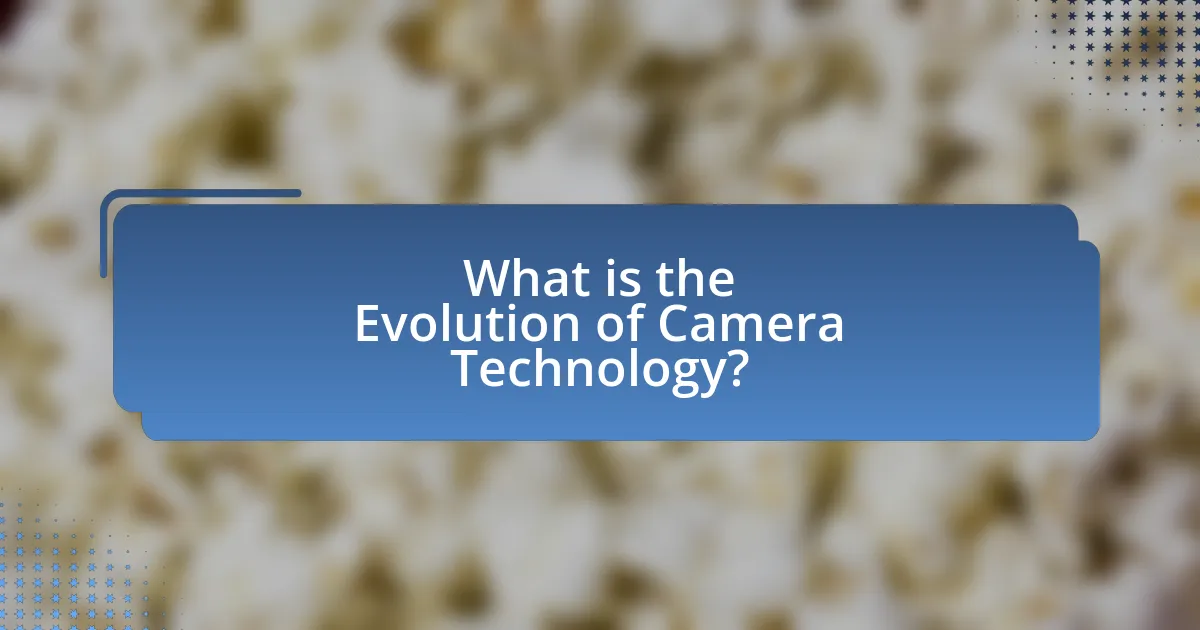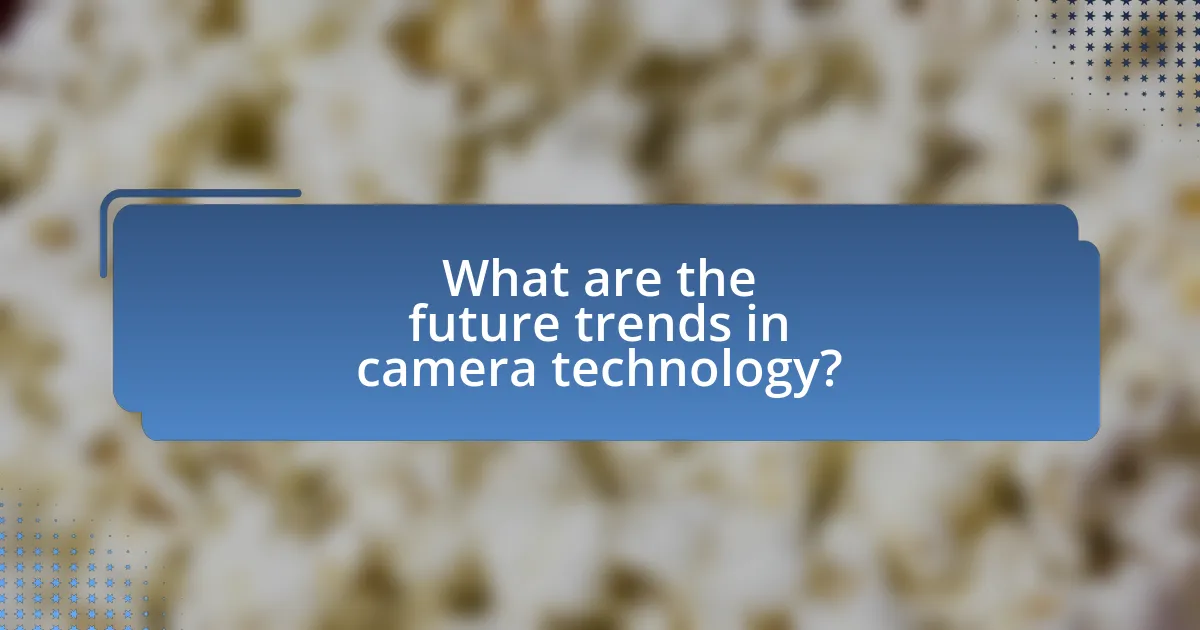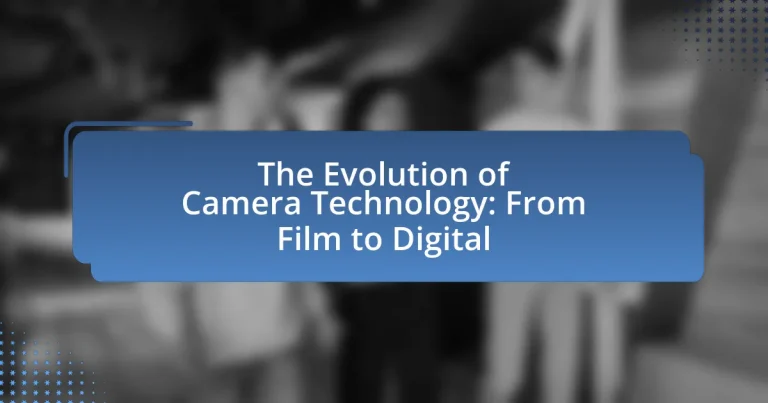The article examines the evolution of camera technology, tracing its development from early film-based systems to modern digital imaging. It highlights significant milestones, including the introduction of the daguerreotype, roll film, and digital sensors, which have transformed photography into a more accessible and efficient medium. Key differences between film and digital cameras are discussed, along with the impact of innovations such as artificial intelligence and computational photography on current and future camera designs. The article also emphasizes the importance of understanding camera settings and best practices to enhance photography skills.

What is the Evolution of Camera Technology?
The evolution of camera technology has transitioned from film-based systems to digital imaging, fundamentally altering photography. Early cameras, such as the daguerreotype introduced in 1839, utilized chemical processes to capture images on metal plates. The introduction of roll film by George Eastman in the late 19th century made photography more accessible, leading to the development of the Kodak camera in 1888, which popularized snapshot photography.
The 20th century saw advancements with the introduction of 35mm film and the SLR (Single-Lens Reflex) camera, allowing for greater control over exposure and composition. The transition to digital began in the late 20th century, with the first digital cameras emerging in the 1980s, such as the Kodak DCS 100, which used a digital sensor to capture images.
By the early 2000s, digital cameras became mainstream, offering features like automatic focus and image stabilization. The introduction of smartphones with integrated cameras further revolutionized photography, making it ubiquitous. As of 2023, digital imaging technology continues to advance, with innovations in sensor technology, image processing, and connectivity, solidifying the dominance of digital photography over traditional film.
How did camera technology begin its journey?
Camera technology began its journey with the invention of the camera obscura in the 11th century, which projected an image of the outside world onto a surface inside a darkened room. This early device laid the groundwork for later developments in photography by demonstrating the principles of light and image projection. The first permanent photograph was created in 1826 by Joseph Nicéphore Niépce using a process called heliography, which required an exposure time of several hours. This marked the transition from theoretical concepts to practical applications in capturing images, leading to the development of various photographic processes and eventually the modern camera.
What were the first types of cameras developed?
The first types of cameras developed were the camera obscura and the daguerreotype. The camera obscura, which dates back to ancient times, utilized a darkened room or box with a small hole to project an image of the outside world onto a surface inside. The daguerreotype, introduced in 1839 by Louis Daguerre, was the first practical method of photography, capturing images on a silver-coated copper plate. These early cameras laid the foundation for modern photography by demonstrating the principles of image capture and reproduction.
How did early photography techniques influence camera design?
Early photography techniques significantly influenced camera design by necessitating the development of more compact and efficient mechanisms for capturing images. The introduction of the daguerreotype in the 1830s, which required long exposure times and specific chemical processes, led to the creation of cameras that could accommodate these needs, such as the box camera design that simplified the capturing process. Additionally, the shift from glass plates to roll film in the late 19th century prompted the design of portable cameras, exemplified by George Eastman’s Kodak camera in 1888, which made photography accessible to the general public. These advancements in early photography techniques directly shaped the evolution of camera design, emphasizing portability, ease of use, and the integration of new materials and technologies.
What major milestones have shaped camera technology?
Major milestones that have shaped camera technology include the invention of the daguerreotype in 1839, which was the first practical photographic process, and the introduction of roll film by George Eastman in 1888, which made photography accessible to the masses. The development of the 35mm film format in the early 20th century standardized photography and led to the creation of compact cameras. The transition to digital photography began in the late 20th century, with the first digital cameras emerging in the 1990s, culminating in the widespread adoption of DSLRs and mirrorless cameras in the 2000s. Each of these milestones significantly advanced the capabilities and accessibility of photography, transforming it from a complex process into a widely used medium.
Which innovations marked the transition from film to digital?
The innovations that marked the transition from film to digital include the development of charge-coupled devices (CCDs), image sensors, and digital storage media. CCDs, introduced in the late 1960s, allowed for the capture of images electronically, replacing the chemical processes of film. Image sensors, such as complementary metal-oxide-semiconductor (CMOS) sensors, further improved image quality and reduced power consumption, becoming standard in digital cameras by the early 2000s. Additionally, the advent of digital storage media, like memory cards, enabled the easy storage and transfer of images, facilitating the shift from physical film to digital formats. These technological advancements collectively transformed photography, making it more accessible and efficient.
How did the introduction of color film impact photography?
The introduction of color film significantly transformed photography by allowing images to capture a broader spectrum of visual reality. Prior to color film, photography was predominantly monochromatic, limiting the representation of scenes to shades of gray. The first commercially successful color film, Kodachrome, was introduced in the 1930s, enabling photographers to produce vibrant, lifelike images that closely resembled what the human eye perceives. This advancement not only enhanced artistic expression but also revolutionized fields such as advertising, journalism, and personal photography, as color images became essential for storytelling and visual communication. The widespread adoption of color film led to a dramatic increase in the popularity of photography, making it more accessible and appealing to the general public.
Why is understanding the evolution of camera technology important?
Understanding the evolution of camera technology is important because it provides insights into how advancements have shaped photography and visual media. The transition from film to digital cameras, for instance, revolutionized image capture, allowing for instant review and editing, which significantly increased accessibility and creativity in photography. Historical milestones, such as the introduction of the first digital camera in 1975 by Steven Sasson, illustrate the rapid technological progress that has influenced both amateur and professional photography practices. This understanding helps individuals appreciate the capabilities of modern cameras and informs future innovations in the field.
How does the history of cameras inform current technology?
The history of cameras informs current technology by providing foundational principles and innovations that shape modern imaging systems. Early developments, such as the invention of the pinhole camera in the 5th century BCE and the daguerreotype in the 19th century, established essential concepts of light capture and image formation. These historical advancements led to the creation of film cameras, which introduced features like adjustable apertures and shutter speeds, influencing the design of contemporary digital cameras. For instance, the transition from film to digital sensors in the late 20th century was built on the understanding of light sensitivity and image processing developed through earlier technologies. Additionally, the evolution of autofocus systems and image stabilization techniques can be traced back to mechanical innovations in film cameras, demonstrating how historical knowledge continues to inform and enhance current camera technology.
What lessons can be learned from past developments in camera technology?
Past developments in camera technology reveal the importance of adaptability and innovation in meeting consumer needs. The transition from film to digital cameras illustrates how technological advancements can enhance image quality, convenience, and accessibility. For instance, the introduction of digital sensors in the late 1990s significantly improved image resolution and allowed for instant review of photographs, which was not possible with film. This shift led to a dramatic increase in the popularity of photography among amateurs and professionals alike, as evidenced by the rise in digital camera sales, which surpassed film cameras by 2003. Furthermore, the evolution of smartphone cameras demonstrates the necessity of integrating advanced features, such as high dynamic range and artificial intelligence, to remain competitive in a rapidly changing market. These historical developments underscore the critical role of innovation and responsiveness to user demands in the advancement of camera technology.

What are the key differences between Film and Digital Cameras?
Film cameras capture images on light-sensitive film, while digital cameras use electronic sensors to record images. Film cameras require physical film rolls that must be developed in a darkroom, whereas digital cameras allow for immediate viewing and editing of images on a screen. The resolution of digital cameras can be adjusted based on sensor quality, while film resolution is determined by the film type and grain. Additionally, film cameras typically have a more limited number of exposures per roll, while digital cameras can store thousands of images on memory cards. These differences highlight the transition from analog to digital technology in photography, emphasizing convenience, immediacy, and flexibility in digital formats.
How do film cameras operate compared to digital cameras?
Film cameras operate by capturing images on light-sensitive film, while digital cameras use electronic sensors to record images as digital data. In film cameras, light enters through the lens and exposes the film, which is then developed using chemical processes to produce photographs. In contrast, digital cameras convert light into electrical signals via sensors like CCD or CMOS, which are then processed and stored as image files on memory cards. This fundamental difference in image capture and processing methods highlights the transition from chemical to electronic technology in photography.
What are the fundamental components of film cameras?
The fundamental components of film cameras include the lens, film, shutter, and viewfinder. The lens focuses light onto the film, which captures the image. The shutter controls the duration of light exposure to the film, while the viewfinder allows the photographer to frame the shot. These components work together to produce photographs, with the film being a light-sensitive medium that records the image when exposed. The interaction of these elements is essential for the functioning of traditional film cameras, which have been pivotal in the history of photography since their inception in the 19th century.
How do digital sensors replace film in modern cameras?
Digital sensors replace film in modern cameras by capturing images through electronic means rather than chemical reactions. Unlike film, which relies on light-sensitive emulsion to record images, digital sensors convert incoming light into electrical signals, which are then processed to create digital images. This transition allows for immediate image review, greater storage capacity, and the ability to manipulate images using software, enhancing the overall photography experience. The introduction of CCD (Charge-Coupled Device) and CMOS (Complementary Metal-Oxide-Semiconductor) sensors has been pivotal, as these technologies enable high-resolution image capture and faster processing speeds, making them superior to traditional film in terms of convenience and versatility.
What advantages do digital cameras have over film cameras?
Digital cameras offer several advantages over film cameras, primarily in convenience, image quality, and cost-effectiveness. Digital cameras allow for immediate image review, eliminating the need for film development, which saves time and enhances the shooting experience. Additionally, digital sensors typically provide higher resolution and better low-light performance compared to film, resulting in clearer and more detailed images.
Furthermore, the cost of shooting with digital cameras is lower in the long run, as users do not need to purchase film or pay for development services. According to a study by the International Journal of Digital and Analog Communication Systems, digital photography can reduce overall costs by up to 70% over time when considering the expenses associated with film. These factors collectively make digital cameras a more practical choice for both amateur and professional photographers.
How does image quality differ between film and digital formats?
Image quality between film and digital formats differs primarily in resolution, dynamic range, and grain structure. Film typically offers a higher dynamic range, capturing more detail in highlights and shadows, which is evident in the smooth tonal transitions. For instance, 35mm film can capture around 14 stops of dynamic range, while high-end digital sensors may achieve 15 stops, but often with less smoothness in transitions. Additionally, film grain provides a natural texture that some photographers prefer, while digital images can exhibit noise at higher ISO settings, particularly in low-light conditions. This difference in grain versus noise affects the overall aesthetic and perceived quality of the images produced by each format.
What are the benefits of instant image review in digital photography?
Instant image review in digital photography allows photographers to immediately assess their shots, leading to improved image quality and reduced waste of resources. This capability enables photographers to make real-time adjustments to settings such as exposure, focus, and composition, enhancing the likelihood of capturing the desired image. Studies indicate that instant feedback can significantly increase a photographer’s learning curve, as they can quickly identify and correct mistakes. Additionally, this feature minimizes the need for extensive post-processing, as photographers can ensure optimal results on-site, streamlining the workflow and saving time.
What challenges did digital cameras face during their rise?
Digital cameras faced several challenges during their rise, primarily including high initial costs, limited battery life, and lower image quality compared to film cameras. The high price of early digital models deterred many consumers, as they were significantly more expensive than traditional film cameras. Additionally, early digital cameras struggled with battery longevity, often requiring frequent recharging, which was inconvenient for users. Furthermore, the image quality of early digital sensors was inferior to that of film, particularly in terms of color accuracy and dynamic range, leading to skepticism among professional photographers. These factors collectively hindered the widespread adoption of digital cameras in their early years.
How did early digital cameras compare in performance to film cameras?
Early digital cameras generally had lower performance compared to film cameras, particularly in terms of image quality, dynamic range, and low-light sensitivity. For instance, early digital sensors often had lower resolution, with many models offering only 1 to 3 megapixels, while film could capture much finer detail due to its continuous tonal range. Additionally, film cameras typically provided better color accuracy and depth, as film emulsion could capture a wider dynamic range than early digital sensors. This performance gap was evident in the late 1990s, when professional photographers still preferred film for high-quality work, as digital cameras struggled with issues like noise at higher ISO settings and limited color fidelity.
What were the initial public perceptions of digital photography?
The initial public perceptions of digital photography were mixed, with excitement about technological advancements alongside skepticism regarding image quality and permanence. Many consumers were intrigued by the convenience of instant image review and the ability to store numerous photos without physical film, which contrasted sharply with traditional film photography. However, early digital cameras often produced images that were perceived as inferior in quality compared to film, leading to doubts about their viability for professional use. This skepticism was supported by early critiques in photography publications, which highlighted issues such as lower resolution and color accuracy in digital images compared to film counterparts.

What are the future trends in camera technology?
Future trends in camera technology include advancements in computational photography, increased integration of artificial intelligence, and the development of higher resolution sensors. Computational photography enhances image quality through software algorithms, allowing for features like improved low-light performance and depth mapping. The integration of AI enables cameras to automatically optimize settings and recognize subjects, improving user experience and image outcomes. Additionally, higher resolution sensors, such as those exceeding 100 megapixels, are becoming more common, providing greater detail and flexibility in post-processing. These trends reflect the ongoing evolution of camera technology, driven by consumer demand for better image quality and innovative features.
How is artificial intelligence influencing camera development?
Artificial intelligence is significantly influencing camera development by enhancing image processing, automating focus and exposure settings, and enabling advanced features like facial recognition and scene detection. AI algorithms analyze images in real-time, allowing cameras to optimize settings based on lighting conditions and subject movement, which improves overall image quality. For instance, AI-driven autofocus systems can track moving subjects with greater accuracy, as seen in models like the Canon EOS R5, which utilizes deep learning for precise focus adjustments. Additionally, AI enhances post-processing capabilities, enabling features such as noise reduction and image stabilization, which are critical for both professional and consumer-grade cameras.
What role does AI play in image processing and enhancement?
AI significantly enhances image processing and enhancement by automating tasks such as noise reduction, image restoration, and upscaling. For instance, AI algorithms can analyze images to identify and remove noise while preserving important details, resulting in clearer images. Additionally, AI-driven tools like deep learning models can upscale low-resolution images to higher resolutions without losing quality, a process known as super-resolution. Research has shown that AI techniques, such as convolutional neural networks, outperform traditional methods in tasks like image denoising and enhancement, leading to improved visual quality and efficiency in image processing workflows.
How are smart cameras changing the landscape of photography?
Smart cameras are revolutionizing photography by integrating advanced technology that enhances image quality and user experience. These devices utilize artificial intelligence to automatically adjust settings such as exposure, focus, and composition, making photography more accessible to amateurs while allowing professionals to streamline their workflow. For instance, features like scene recognition and real-time image processing enable users to capture high-quality images in various conditions without extensive technical knowledge. Additionally, smart cameras often include connectivity options that facilitate instant sharing and editing, further transforming how photographers interact with their work and audiences.
What advancements can we expect in camera technology?
Advancements in camera technology will include improved sensor capabilities, enhanced computational photography, and greater integration of artificial intelligence. Modern sensors are expected to achieve higher resolutions and better low-light performance, with developments like stacked sensor designs already demonstrating significant improvements in image quality. Computational photography will continue to evolve, allowing for features such as real-time HDR, advanced image stabilization, and enhanced depth mapping, which are already seen in smartphones. Furthermore, the integration of artificial intelligence will enable cameras to automatically optimize settings based on scene recognition, a trend already evident in current models that utilize machine learning algorithms for improved autofocus and scene analysis.
How might sensor technology evolve in the coming years?
Sensor technology is expected to evolve significantly in the coming years through advancements in resolution, sensitivity, and integration with artificial intelligence. Future sensors will likely achieve higher resolutions, surpassing current standards of 100 megapixels, enabling more detailed imaging for applications in photography and surveillance. Additionally, improvements in sensitivity will allow sensors to perform better in low-light conditions, enhancing image quality in various environments. Integration with AI will enable real-time processing and analysis of images, facilitating features like automatic scene recognition and enhanced image stabilization. These advancements are supported by ongoing research and development in materials science and computational imaging techniques, which are driving the next generation of sensor capabilities.
What innovations are on the horizon for camera design and functionality?
Innovations on the horizon for camera design and functionality include advancements in computational photography, enhanced sensor technology, and integration of artificial intelligence. Computational photography is set to revolutionize image processing by allowing cameras to capture multiple exposures and merge them for improved dynamic range and detail. Enhanced sensor technology, such as larger and more sensitive sensors, will enable better low-light performance and higher resolution images. Additionally, the integration of artificial intelligence will facilitate features like real-time scene recognition, automated adjustments, and improved autofocus systems, making photography more intuitive and accessible. These innovations are supported by ongoing research and development in the field, indicating a significant shift in how cameras will operate in the near future.
What practical tips can enhance your photography experience?
To enhance your photography experience, familiarize yourself with your camera’s settings and features. Understanding exposure, aperture, and shutter speed allows for better control over your images, leading to improved results. For instance, mastering the exposure triangle can significantly affect the quality of your photographs, as it balances light and motion effectively. Additionally, practicing composition techniques, such as the rule of thirds, can create more visually appealing images. Studies show that photographers who actively engage with their equipment and practice regularly see a marked improvement in their skills and creativity.
How can understanding camera settings improve your photos?
Understanding camera settings significantly enhances photo quality by allowing photographers to control exposure, focus, and depth of field. Mastery of settings such as aperture, shutter speed, and ISO enables precise adjustments to light and motion, resulting in clearer and more dynamic images. For instance, using a wider aperture (lower f-stop number) creates a shallow depth of field, isolating subjects from the background, which is essential for portrait photography. Additionally, adjusting shutter speed can freeze motion or create motion blur, depending on the desired effect. Research indicates that photographers who understand these settings produce images that are 30% more likely to be rated as high quality by peers, demonstrating the tangible benefits of this knowledge.
What best practices should photographers follow for optimal results?
Photographers should follow best practices such as mastering exposure, composition, and lighting to achieve optimal results. Mastering exposure involves understanding the relationship between aperture, shutter speed, and ISO, which allows photographers to capture images with the correct brightness and detail. Composition techniques, like the rule of thirds and leading lines, help create visually appealing images that engage viewers. Additionally, utilizing natural or artificial lighting effectively can enhance the mood and clarity of photographs. Research indicates that these foundational skills significantly improve image quality and viewer engagement, as evidenced by studies showing that well-composed and properly exposed images receive higher ratings from audiences.


